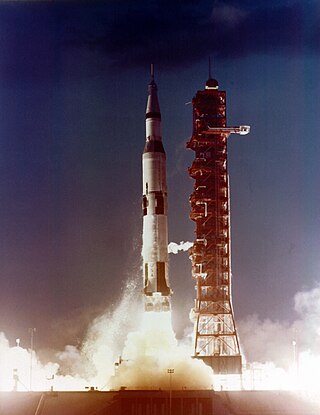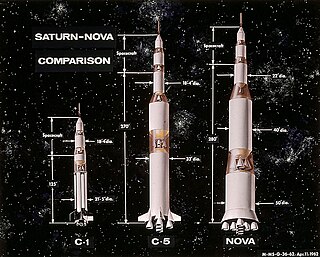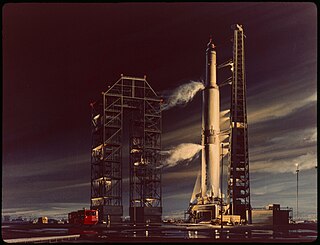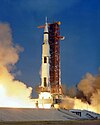Related Research Articles

The Apollo program, also known as Project Apollo, was the United States human spaceflight program carried out by the National Aeronautics and Space Administration (NASA), which succeeded in preparing and landing the first men on the Moon in 1969. It was first conceived in 1960 during President Dwight D. Eisenhower's administration as a three-person spacecraft to follow the one-person Project Mercury, which put the first Americans in space. Apollo was later dedicated to President John F. Kennedy's national goal for the 1960s of "landing a man on the Moon and returning him safely to the Earth" in an address to Congress on May 25, 1961. It was the third US human spaceflight program to fly, preceded by the two-person Project Gemini conceived in 1961 to extend spaceflight capability in support of Apollo.

Apollo 4, also known as SA-501, was the uncrewed first test flight of the Saturn V launch vehicle, the rocket that eventually took astronauts to the Moon. The space vehicle was assembled in the Vehicle Assembly Building, and was the first to be launched from Kennedy Space Center (KSC) in Florida, ascending from Launch Complex 39, where facilities built specially for the Saturn V had been constructed.

The S-IVB was the third stage on the Saturn V and second stage on the Saturn IB launch vehicles. Built by the Douglas Aircraft Company, it had one J-2 rocket engine. For lunar missions it was fired twice: first for Earth orbit insertion after second stage cutoff, and then for translunar injection (TLI).

The Saturn family of American rockets was developed by a team of former German rocket engineers and scientists led by Wernher von Braun to launch heavy payloads to Earth orbit and beyond. The Saturn family used liquid hydrogen as fuel in the upper stages. Originally proposed as a military satellite launcher, they were adopted as the launch vehicles for the Apollo Moon program. Three versions were built and flown: the medium-lift Saturn I, the heavy-lift Saturn IB, and the super heavy-lift Saturn V.

The Saturn IB was an American launch vehicle commissioned by the National Aeronautics and Space Administration (NASA) for the Apollo program. It uprated the Saturn I by replacing the S-IV second stage, with the S-IVB. The S-IB first stage also increased the S-I baseline's thrust from 1,500,000 pounds-force (6,700,000 N) to 1,600,000 pounds-force (7,100,000 N) and propellant load by 3.1%. This increased the Saturn I's low Earth orbit payload capability from 20,000 pounds (9,100 kg) to 46,000 pounds (21,000 kg), enough for early flight tests of a half-fueled Apollo command and service module (CSM) or a fully fueled Apollo Lunar Module (LM), before the larger Saturn V needed for lunar flight was ready.
The Saturn I was a rocket designed as the United States' first medium lift launch vehicle for up to 20,000-pound (9,100 kg) low Earth orbit payloads. Its development was taken over from the Advanced Research Projects Agency (ARPA) in 1958 by the newly formed civilian NASA. Its design proved sound and flexible. It was successful in initiating the development of liquid hydrogen-fueled rocket propulsion, launching the Pegasus satellites, and flight verification of the Apollo command and service module launch phase aerodynamics. Ten Saturn I rockets were flown before it was replaced by the heavy lift derivative Saturn IB, which used a larger, higher total impulse second stage and an improved guidance and control system. It also led the way to development of the super-heavy lift Saturn V which carried the first men to landings on the Moon in the Apollo program.

Nova was a series of NASA's rocket designs that were proposed both before and after the Saturn V rocket used in the Apollo program. Nova was NASA's first large launcher proposed in 1958, for missions similar to what Saturn V was subsequently used for. The Nova and Saturn V designs closely mirrored each other in basic concept, power, size, and function. Differences were minor but practical, and the Saturn was ultimately selected for the Apollo program, largely because it would reuse existing facilities to a greater extent and could make it to the pad somewhat earlier.
Several planned missions of the Apollo crewed Moon landing program of the 1960s and 1970s were canceled, for reasons which included changes in technical direction, the Apollo 1 fire, the Apollo 13 incident, hardware delays, and budget limitations. After the landing by Apollo 12, Apollo 20, which would have been the final crewed mission to the Moon, was canceled to allow Skylab to launch as a "dry workshop". The next two missions, Apollos 18 and 19, were later canceled after the Apollo 13 incident and further budget cuts. Two Skylab missions also ended up being canceled. Two complete Saturn V rockets remained unused and were put on display in the United States.
The Saturn C-2 was the second rocket in the Saturn C series studied from 1959 to 1962. The design was for a four-stage launch vehicle that could launch 21,500 kg (47,300 lb) to low Earth orbit and send 6,800 kg (14,900 lb) to the Moon via Trans-Lunar Injection.
The C-2 design concept was for a proposed crewed circumlunar flight and the Earth orbit rendezvous (EOR) missions. It was initially considered for the Apollo lunar landing at the earliest possible date (1967).

The Saturn C-4 was the fourth rocket in the Saturn C series studied from 1959 to 1962. The C-4 design was proposed in 1960 for a three-stage launch vehicle that could launch 99,000 kg (218,000 lb) to low Earth orbit and send 32,000 kg (70,000 lb) to the Moon via trans-lunar injection. It met the initial requirements for a lunar orbit rendezvous and lunar landing mission.
The Juno V series of rockets were a design that was proposed in the late 1950s but cancelled. The rockets were multi-stage and, although they failed to reach production, their sections were used in other designs.

The Saturn C-3 was the third rocket in the Saturn C series studied from 1959 to 1962. The design was for a three-stage launch vehicle that could launch 45,000 kilograms (99,000 lb) to low Earth orbit and send 18,000 kilograms (40,000 lb) to the Moon via trans-lunar injection.
Studied in 1965, the same year that Project Gemini started, the Saturn IB-C was simply designed as an orbital launch vehicle like the original Saturn IB. The booster would consist of an ordinary Saturn IB with four Minuteman first stages used as strap-on boosters. The Saturn IB core booster did fly from 1966 until 1975, but never with any strap-on boosters.

The Saturn V-3, also known as the Saturn MLV 5-3, was a conceptual heavy-lift launch vehicle that would have utilized new engines and new stages that were never used on the original Saturn V. The Saturn V-3 was studied by the NASA Marshall Space Flight Center in 1965.
Saturn V-A was a proposed American orbital launch vehicle. It was studied by Marshall Space Flight Center in 1968. the Saturn V-A was identical to the Saturn INT-20, except it consisted of an ordinary S-IC first stage and S-IVB second stage. For deep-space missions, a Centaur third stage could also have been used.
Studied in 1968 by Marshall Space Flight Center, the Saturn V-B was considered an interesting vehicle concept because it nearly represents a single-stage to orbit booster, but is actually a stage and a half booster just like the Atlas. The booster would achieve liftoff via five regular F-1 engines; four of the five engines on the Saturn V-B would be jettisoned and could be fully recoverable, with the sustainer stage on the rocket continuing the flight into orbit. The rocket could have had a good launch capability similar to that of the Space Shuttle if it was constructed, but it never flew.
The Saturn V-D was a conceptual booster with the ability to launch three times as much payload as the Russian Energia booster. Studied in 1968, it was considered to be the mightiest of the proposed variations of the Saturn V rocket, rehashed as one of the boosters from the Boeing 1967 Saturn studies and utilizing the stage and a half Saturn V-B, four 100 ft tall SRBs, and the ordinary second and third stages of the original Saturn V. This booster never flew, but if it had been manufactured it would have had the capability to launch all the necessary components for a space station in one shot.
Studied by Douglas Aircraft Company in 1965, this rocket consisted of a whole Saturn IB with 4 strap-on SRBs that have flown on the Titan 3E interplanetary missile carriers. All components of the vehicle have flown, but not together for this concept.

The Saturn V dynamic test vehicle, designated SA-500D, is a prototype Saturn V rocket used by NASA to test the performance of the rocket when vibrated to simulate the shaking which subsequent rockets would experience during launch. It was the first full-scale Saturn V completed by the Marshall Space Flight Center (MSFC). Though SA-500D never flew, it was instrumental in the development of the Saturn V rocket which propelled the first men to the Moon as part of the Apollo program. Built under the direction of Dr. Wernher von Braun, it served as the test vehicle for all of the Saturn support facilities at MSFC.

The Saturn V is a retired American super heavy-lift launch vehicle developed by NASA under the Apollo program for human exploration of the Moon. The rocket was human-rated, had three stages, and was powered by liquid fuel. Flown from 1967 to 1973, it was used for nine crewed flights to the Moon, and to launch Skylab, the first American space station.
References
- Lowther, Scott, Saturn: Development, Details, Derivatives and Descendants, Work in progress. Available chapters may be ordered directly from Scott Lowther at web site indicated. Accessed at: https://saemobilus.sae.org/content/680358
